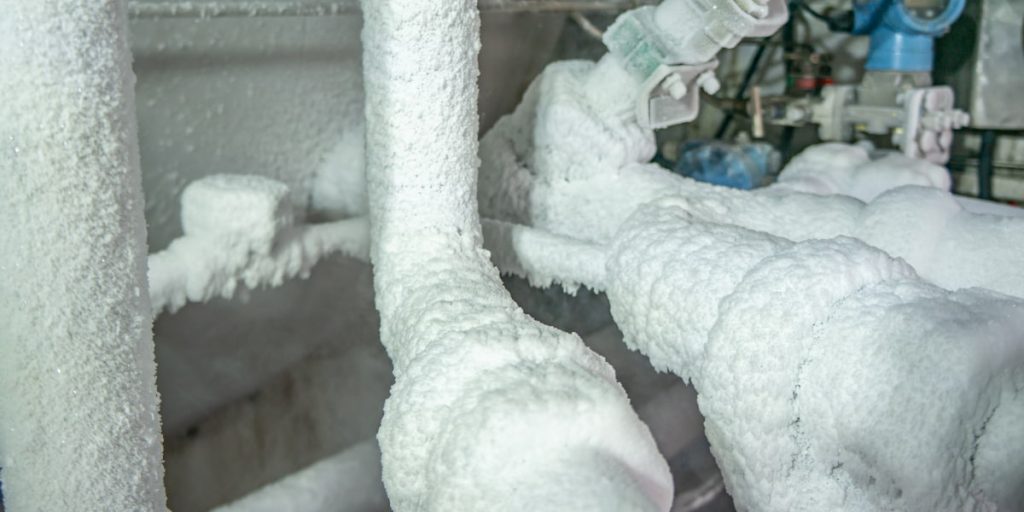Published on December 23rd, 2022
Last updated on February 3rd, 2023
Unfreezing Pipes: How To Thaw Frozen Pipes Without Damaging Them

In winter, it’s not only us who can get cold but also the supplies. That is why we can observe such an unpleasant phenomenon as the freezing of drains and water pipes in private buildings. And if a person only needs to drink a cup of hot tea to warm, the pipes will be more difficult to warm up. We wish it were as easy as wrapping up in a blanket and sitting around the heater. You will have to deal with the utilities if there is frozen water. Also, you can take the initiative into your own hands and find out how to thaw frozen pipes.
Unfreezing the sewer pipes is much easier than full repair. Because the water will flow into the drainage pit through thawing. This process is much more difficult for the water supply system in the building. Often the pipes are underground, and digging frozen soil is very hard. This article will look at several popular ways to defrost frozen pipes.
How to Thaw Frozen Pipes?

Warming frozen pipes are problematic sometimes. So it is worth choosing the appropriate method for this. The method depends on the location. It is also worth considering the length of the frozen area and the material. Before you start the heating work, you must turn off the water supply. Also, you have to open the faucet closest to the frozen section of the pipeline.
If the pipes are metal, the defrosting process is quite simple. To do this, take an ordinary welding machine and connect it to the different ends of the pipe.
But what to do if the plastic pipe is frozen? They are not subject to corrosive processes and do not collapse when frozen. According to its properties, polyethylene is not a conductor of electric current. Thus, the only way out is to use hot water to defrost.
It is also possible to defrost pipes using special hairdryers. Below you can read about all the methods in more detail.
How to Thaw a Frozen Pipe With a Hair Dryer or Blowtorch
If the outer part of the pipe, which is within reach, is frozen, the task is greatly simplified. It is enough just to expose the frozen area to external heating, and for this, you can use:
- hair dryer, regular or construction;
- heating cable;
- heater;
- electric blanket.
If the pipe is metal, you can also use heat sources:
- gas torch;
- blowtorch;
- homemade torch.
The principle in all cases is the same. To defrost frozen pipes in the area, you need to affect them with heat. If it is a heater, then apply it. If it’s a cable, wrap it around the pipe and plug it in. And if you have a torch or blowtorch, point the flame at a section of pipe. Your task is to direct the hot air on the pipe with a hair dryer. You can wrap the heating pad, heating cable, and thermal blanket. Use an old blanket or thick fabric for this. You have to do it to keep the heat in.
It is important to open the water faucet before you begin. So that the thawed water can safely flow out of the pipe. Turn off the heating boiler for this time.
Thawing Pipes With Boiling Water and a Rag
The method is also suitable if the pipes are in the building and accessible. Of course, you can simply pour hot water on the pipes, previously setting containers to collect water, but much more effective to first wrap the pipes with a rag. And then arrange them “hot shower.” The rags will absorb the water, get hot and contribute to the constant heat exposure of the pipes. If you do not have a lot of rags, you will need to move them around the pipe section periodically. Don’t forget to set up a container to collect the absorbed water. So your pipes unfreezing will go very well.
Defrost Frozen Pipes by Using a Welder
The clever owners of private homes invented this technology of pipe heating. The method gives electricity to the frozen area with a welding machine. Depending on the degree of freezing, you can adjust the current up or down. The procedure will be as follows:
- You have to connect the wires from the welder to the ends of the frozen section and wrap the wire around it.
- Then you have to turn on the equipment for about half a minute.
- After a short break, you need to repeat this process.
- If the pipe does not get hot during this process, you need to increase the machine’s current.
Industrial systems for thawing frozen pipes work according to this principle:
- The terminals are connected to the ends of the section to be defrosted.
- You connect the machine to the mains.
- Then, you apply amperage to the tube. Using such a device, a pipe with a length of 25 meters and a diameter of 6 centimeters defrosts in about 1 hour. So if the structure has a diameter greater than 6 centimeters, it is better to defrost it in separate parts. So it will be faster.
Why Are the Pipes Freezing?

No, this is not a rhetorical question. The reason often lies in our neglect of the lines. Yes, we, consciously or not, violate the standards, and as a result, amid fierce winter, we get an unpleasant consequence in the form of frozen water pipes or, worse, sewage.
Pipes freeze for the following reasons:
- Insufficient depth of burial. Ideally, the pipes should be below freezing ground level. But in some regions, this level is 1.8-2 meters deep or even more. Utilities and private developers sometimes do not adhere to this rule. It happens because of faulty calculations or in an attempt to save money;
- Inefficient insulation. To prevent yourself from thawing a frozen pipe in the winter, it is necessary to insulate them. And those places of pipes that pass through the foundation need double insulation. Since these materials cool faster than the ground. It is better not to place pipes close to brick and concrete structures for the same reason. The exception is the enter to the house;
- Low water consumption. In private unheated houses, you can not leave water in the pipes. It is better to drain it before winter;
- Too smallpipe’s diameter. The smaller the diameter, the faster the liquid freezes. Under the ground is not recommended to lay water pipes with a diameter less than 50 mm;
- Even if the depth of laying pipes is sufficient, and they are well insulated, freezing may occur at shallow temperatures, not typical for the region. It is already an emergency.
If it so happens that frozen pipes occur, you have to defrost them with your forces. Then, first, you have to find a place for freezing water. It can be exterior areas or underground. The methods of defrosting will be different.
Bottom Line
Of course, when thawing pipes, you must remember safety. Especially when it comes to working with an open fire. You should refrain from using this technology to defrost plastic pipes. Despite the wide range of valuable equipment to remove ice plugs from pipes when freezing. It is best not to bring the situation to such problems. Don’t forget that saving money on insulation can turn into serious problems, and the miser pays twice. Also, we recommend reading more about our useful DIYs.
FAQ
How to avoid a frozen pipe?
Observe the required depth of laying the pipe structure. It should not be less than the depth of frost penetration in your region. The most vulnerable places of the system are the points of entry of pipes into the distribution wells and the house. These areas should be carefully insulated with thermal insulation material and protected against moisture.
How long do frozen pipes take to thaw?
Usually, when people thaw frozen pipes, it takes 30 to 60 minutes. However, when frozen pipes are thawed naturally, it can take days, weeks, months, or even years.
How to warm a frozen pipe quickly?
Saltwater is heavier than fresh water and will gradually pass through the pipeline, melting the ice. If there is a septic tank, you can try to get to the icing through it and use a hose and hot water to warm the frozen area. The sewer is heated with a heating cable or hot water.
How to thaw a plastic pipe?
Here you can use a construction hair dryer, a regular household hair dryer, or a heat fan. For convenient heating of a large section of plastic pipe, you can make an air duct from improvised materials. For example, by wrapping this gap in the system with cardboard and paper.


